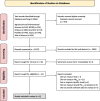Quantifying the association between PM2.5 air pollution and IQ loss in children: a systematic review and meta-analysis
- PMID: 39551729
- PMCID: PMC11572473
- DOI: 10.1186/s12940-024-01122-x
Quantifying the association between PM2.5 air pollution and IQ loss in children: a systematic review and meta-analysis
Abstract
Background: A growing body of epidemiologic and toxicologic literature indicates that fine airborne particulate matter (PM2.5) pollution is neurotoxic and threatens children's neurobehavioral development, resulting in reduced cognitive function. Understanding the magnitude of this effect is critical for establishing public health policies that will protect children's health, preserve human capital, and support societal progress.
Objective: To quantify the association between ambient PM2.5 air pollution and loss of cognitive function in children, as measured by Intelligence Quotient (IQ) scores, through a systematic literature review and meta-analysis.
Methods: Following PRISMA guidelines, we conducted a systematic literature search across seven databases: Agricultural and Environmental Science, BIOSIS Citation Index, Embase, GreenFILE, PubMed, Scopus, and Web of Science to identify original scientific studies that investigated the impact of PM2.5 exposure during pre-and postnatal periods on IQ loss during childhood. Using data from studies included for final review, we conducted a meta-analysis, using a random effects model to compute a beta coefficient that quantifies the overall effect of PM2.5 exposure on Full-Scale IQ (FSIQ), Performance IQ (PIQ), and Verbal IQ (VIQ).
Findings: Of the 1,107 unique publications identified, six studies met the inclusion criteria for final review, representing 4,860 children across three continents (North America, Europe, and Asia). The mean PM2.5 concentration across all studies was 30.4 ± 24.4 µg/m3. Exposure timing ranged from the prenatal period to mid-childhood. Children were an average of 8.9 years old at the time of cognitive testing. We found that each 1 µg/m3 increase in PM2.5 concentration is associated with a -0.27 point change in FSIQ (p < 0.001), 0.39 point change in PIQ (p = 0.003), and -0.24 point change in VIQ (p = 0.021).
Conclusion: Through a systematic review and meta-analysis, we identified a statistically significant relationship between increased exposure to PM2.5 air pollution and reduced cognitive function in children, with the most pronounced impact on PIQ. This analysis will enable estimation of the burden of adverse neurobehavioral development attributable to PM2.5 in pediatric populations and will inform local and global strategies for exposure prevention.
Keywords: Ambient air pollution; Burden of disease; Children’s environmental health; Cognitive function; IQ; PM2.5.
© 2024. The Author(s).
Conflict of interest statement
Figures
References
-
- Xing YF, Xu YH, Shi MH, Lian YX. The impact of PM2.5 on the human respiratory system. J Thorac Dis. 2016;8(1). Available from: https://jtd.amegroups.org/article/view/6353. Cited 2024 Mar 15. - PMC - PubMed
-
- Fuller R, Landrigan PJ, Balakrishnan K, Bathan G, Bose-O’Reilly S, Brauer M, et al. Pollution and health: a progress update. Lancet Planet Health. 2022;6(6):e535–47. - PubMed
Publication types
MeSH terms
Substances
LinkOut - more resources
Full Text Sources
Medical
Miscellaneous



